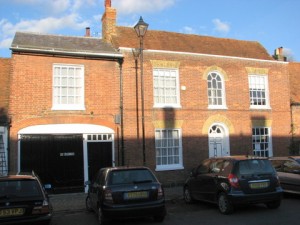Nos 121 to 125. These three cottages (above right) are listed buildings grade II. They have old tile roofs and large chimneys and were built in the 17th century but with a new façade in the 18th. The photo in the gallery below taken in the 1960s shows little difference from today.
No. 121 was a café known as Victory Tea Rooms during the years 1940 to 1950. It was run by Mrs. Smith. It was a very successful little café and mostly used by the Solicitors nearby and the Council Office Staff. The business closed down because Mrs. Smith put two advertising boards outside the Cafe, one outside her window and the other in the kerb near the trees mainly for the weekend trade. The County Council made her take them away and with the subsequent loss of trade the business closed down. It then reverted back to a private house and was bought by Jill Sutcliffe.
 No. 127 (Severn House) (right) is again listed grade II and has an 18th century re-fronting of an earlier building and has an elegant Georgian fanlight over the panel door. There is an arch (now a garage) to allow a coach and horses to pass through to stables at the rear.
No. 127 (Severn House) (right) is again listed grade II and has an 18th century re-fronting of an earlier building and has an elegant Georgian fanlight over the panel door. There is an arch (now a garage) to allow a coach and horses to pass through to stables at the rear.
The census returns from 1841 to 1911 show that the house was occupied by better-off families.
- William Martin b 1784 a ‘Landed Proprietor’ is recorded in 1841 and 1851.
- Ralph Nesbit b 1828, described as ‘Farmer of 280 acres employing 8 men and 3 boys’ was living in the house in 1861.
- Matilda Statham, whose income came from annuities was recorded in 1871, 1881 and 1891.
- In 1901 the house was occupied by Robert Orton aged 54 who was described as Poor Law Guardian. He had previously lived five doors up at 137 in 1881 and 1891 when he was described as a solicitor’s clerk.
- In 1911 Robert Orton was described as ‘retired clerk to the Guardians’ living with his wife, Martha and five sons:
- Robert William Orton emigrated to New Zealand
- Thomas Winfield Orton was a professional cricketer.
- Hugh Orton enlisted to fight in autumn 1914 with Reginald Mason from the Eagle.
- Gerald went to Canada and then joined his brother Robert in New Zealand.
No. 129 (top left once known as Wee Oaks) is a very small late 16th century or early 17th century house. It had only “one up, one down”. It was later extended at the back and is listed grade II. Right next to the big house (no. 127) owned by landed proprietors, lived:
- In 1841 a tallow chandler (dealer in candles) – James Hollis aged 45
- In 1851 a sawyer – John Slater
- In 1861 a carpenter – John’s son, James Slater aged 27
- John Stevens lived in the house for many years. In the 1871 census he was aged 47 and described as an agricultural labourer. Ten year’s later he had become a miller’s labourer. In the 1891 census he had left the house and was living in Barn Meadow as a miller, but he was back in the house in 1901 as a 77 year old pensioner.
- The 1881 resident was George Dobson, a baker.
- In 1911 the house was occupied by Charles Atkins, a Brewer’s Labourer with a wife and 6 month son. They had a lodger, Frederick Gladman who was a farm labourer.
Click on any of the photographs below to enlarge it and to see the description. Then click on forward or back arrows at the foot of each photograph. To close the pictures, just click on one.





